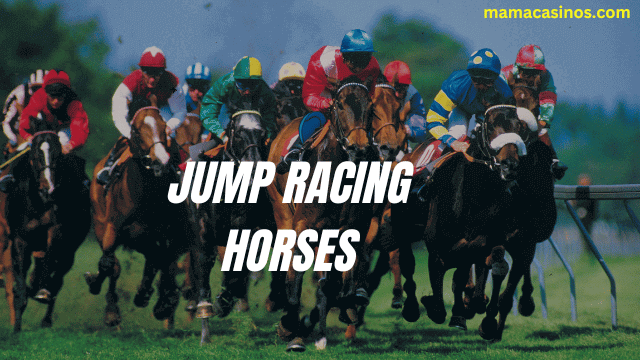Jump racing, also known as National Hunt racing, is a popular form of horse racing that takes place over obstacles such as hurdles and fences. It is a test of both the horse’s speed and jumping ability, as well as the jockey’s skill in navigating the course.
Jump racing horses are a special breed, carefully selected and trained to excel in this type of racing. They need to be strong, agile, and able to jump high obstacles while maintaining their speed and stamina. They also need to have a competitive spirit and the willingness to push themselves to their limits.
There are different types of jump racing horses, including hurdlers, chasers, and stayers. Hurdlers are horses that specialize in jumping over hurdles, which are lower and less challenging obstacles than fences. Chasers, on the other hand, are horses that are trained to jump over fences, which require more skill and technique. Stayers are horses that excel in longer distance races, usually over three miles, and require great stamina and endurance.
Jump racing horses are often bred specifically for this type of racing, with bloodlines that can be traced back to famous jump racing champions. They are trained rigorously from a young age, with a focus on developing their jumping ability, speed, and endurance. They are also carefully looked after, with specialized diets and exercise programs to keep them healthy and in peak condition.
Jump racing is a thrilling and exciting sport that requires a combination of skill, athleticism, and bravery from both the horse and the jockey. Jump racing horses are truly remarkable animals, and their performances on the track are a testament to their strength and abilities.
Why Jump Racing Horses are different from other horses
Jump racing horses are different from other horses in several ways, including their physical attributes, temperament, and training.
Firstly, jump racing horses are bred and selected specifically for their ability to perform in this type of racing. They are typically larger and more muscular than other horses, with a strong, powerful build that allows them to jump high obstacles and maintain their speed over long distances.
Secondly, jump racing horses have a unique temperament that sets them apart from other horses. They are highly competitive and driven, with a strong desire to win. They are also intelligent and responsive, able to quickly adapt to changing conditions on the course and respond to their jockey’s commands.
Finally, jump racing horses undergo a rigorous training regimen that is specifically designed to prepare them for the physical and mental demands of jump racing. They are trained to jump over obstacles, develop their speed and endurance, and build the strength and stamina needed to compete at the highest level.
Overall, jump racing horses are a special breed of horse that have been carefully selected and trained to excel in this exciting and demanding sport. Their unique combination of physical attributes, temperament, and training make them well-suited to the challenges of jump racing, and they are truly remarkable animals to watch and admire.
Characteristics of Jump Racing Horses
Jump racing horses have several key characteristics that make them well-suited for this type of racing.
- Athleticism: Jump racing horses are highly athletic animals that possess a combination of speed, agility, and power. They are capable of running at high speeds and jumping over large obstacles, making them ideal for this type of racing.
- Stamina: Jump racing horses also have a high level of stamina, allowing them to maintain their speed and endurance over long distances. This is especially important in longer races, where horses need to pace themselves to conserve energy for the later stages of the race.
- Bravery: Jump racing horses are also known for their bravery and willingness to take on challenging obstacles. They need to be confident and fearless when jumping over fences and hurdles, and they must be able to think quickly and adjust their stride to clear the obstacles safely.
- Trainability: Jump racing horses are highly trainable and responsive to their jockey’s commands. They must be able to quickly adapt to changing conditions on the course, and they must be able to respond to the jockey’s cues to maintain their speed and avoid obstacles.
- Competitive Spirit: Finally, jump racing horses have a strong competitive spirit and a desire to win. They are bred and trained specifically for this type of racing, and they thrive on the excitement and adrenaline of competition.
Overall, jump racing horses are remarkable animals with a unique set of characteristics that make them well-suited for this challenging and exciting sport.
Breeds of Jump Racing Horses
There are several breeds of horses that excel in jump racing, each with their own unique characteristics and strengths. Here are some of the most popular breeds used in jump racing:
- Thoroughbred: Thoroughbreds are one of the most popular breeds for jump racing. They are known for their speed, athleticism, and endurance, making them well-suited for the demands of this type of racing.
- Warmbloods: Warmbloods are a group of horse breeds that were developed specifically for sport. They are typically larger and heavier than Thoroughbreds, and they have a strong, muscular build that gives them the power and agility needed for jump racing.
- Irish Sport Horse: The Irish Sport Horse is a popular breed for jump racing, especially in Ireland where it originated. It is a cross between a Thoroughbred and an Irish Draught horse, resulting in a horse with speed, agility, and strength.
- Hanoverian: The Hanoverian is a German breed that is known for its athleticism and versatility. It has a strong, muscular build that makes it well-suited for jump racing, and it is also used in other equestrian sports such as dressage and show jumping.
- Selle Francais: The Selle Francais is a French breed that was originally developed for military use. It is known for its speed, agility, and jumping ability, making it a popular choice for jump racing.
- American Quarter Horse: While not as common in jump racing as other breeds, the American Quarter Horse is a popular breed for other types of racing such as barrel racing and rodeo events. It has a strong, compact build that gives it the speed and agility needed for jump racing.
Overall, there are several breeds of horses that excel in jump racing, each with their own unique characteristics and strengths. Breeders and trainers carefully select and train horses to compete in this demanding and exciting sport, resulting in some of the most remarkable equine athletes in the world.
Jump Racing Training
Jump racing training is a rigorous and specialized process that is designed to prepare horses for the physical and mental demands of jump racing. Here are some key elements of jump racing training:
- Conditioning: Conditioning is a crucial part of jump racing training. Horses need to be in top physical shape to compete at the highest level, so trainers work to build their strength, endurance, and overall fitness through a combination of exercise, diet, and rest.
- Jump Training: Jump training is an essential part of preparing horses for jump racing. Trainers use a variety of techniques to help horses learn how to jump over obstacles safely and efficiently. This includes training over poles, cavaletti, and other types of jumps, as well as working on technique, timing, and stride length.
- Flatwork: Flatwork is another important component of jump racing training. This involves training horses to move smoothly and efficiently on the flat, which helps to build their strength, balance, and coordination. Trainers use a variety of exercises such as circles, transitions, and lateral movements to improve the horse’s flatwork skills.
- Mental Training: Jump racing can be a challenging and stressful sport for horses, so trainers work to prepare them mentally as well as physically. This involves exposing horses to different environments, sounds, and stimuli to help them become more confident and adaptable on the racecourse.
- Race Preparation: Finally, trainers work to prepare horses specifically for race day. This includes developing a race strategy, practicing the specific course layout and obstacles, and working on timing and pace. Trainers may also adjust the horse’s diet and exercise routine in the days leading up to a race to help ensure they are in peak physical condition.
Overall, jump racing training is a specialized and demanding process that requires careful planning, skill, and experience. With the right training and preparation, horses can become top performers in this exciting and challenging sport.
Equipment and Gear for Jump Racing Horses
Jump racing horses require specialized equipment and gear to help keep them safe and comfortable while competing. Here are some key items of equipment used in jump racing:
- Tack: The tack used for jump racing is similar to that used for other equestrian sports such as show jumping and eventing. It includes a saddle, bridle, bit, and reins. The saddle is designed to be lightweight and secure, with a forward-cut flap to allow for greater freedom of movement. The bridle and bit are chosen to suit the horse’s individual needs and preferences.
- Boots and Bandages: Jump racing horses may wear protective boots or bandages on their legs to help prevent injuries from striking obstacles or from the impact of landing after a jump. These may include tendon boots, splint boots, or brushing boots.
- Ear Plugs: Ear plugs are sometimes used to help horses stay focused and calm during a race. They can help to block out distracting sounds and reduce anxiety.
- Blinkers: Blinkers are a type of eye gear that can be used to limit a horse’s peripheral vision and help them focus on the track ahead. They may be used on horses that are easily distracted or nervous.
- Body Protectors: Body protectors, also known as vests, are worn by jockeys to help protect them from injuries in the event of a fall. They are made of a lightweight, flexible material that provides impact protection while allowing for freedom of movement.
- Racing Plates: Racing plates are lightweight horseshoes that are designed for racing. They are shaped to provide maximum grip and traction on the track, while also allowing for quick acceleration and sharp turns.
Overall, jump racing horses require specialized equipment and gear to help keep them safe and comfortable while competing. Trainers and riders carefully select and fit each piece of equipment to suit the horse’s individual needs and preferences, helping to ensure they are at their best on race day.
Types of Jump Races
Jump racing consists of several different types of races, each with its own unique format and requirements. Here are some of the most common types of jump races:
- Hurdle Races: Hurdle races are the simplest form of jump racing. In these races, horses jump over a series of lightweight hurdles that are set at a fixed height. Hurdles are usually made of brush or a similar material that falls apart easily if hit.
- Steeplechase Races: Steeplechase races are more complex than hurdle races and involve jumping a variety of obstacles including hurdles, ditches, and water jumps. The courses are typically longer and more challenging than hurdle races, with a greater emphasis on endurance and jumping technique.
- Chase Races: Chase races are similar to steeplechase races, but they do not include water jumps. Instead, they may feature more difficult obstacles such as larger fences and ditches.
- Novice Races: Novice races are designed for horses that are new to jump racing or have not yet won a race. These races are typically shorter and less challenging than more advanced races.
- Handicap Races: Handicap races are designed to level the playing field between horses of different abilities. Horses are assigned a weight based on their past performances, with better horses carrying more weight.
- Point-to-Point Races: Point-to-point races are amateur races that are held on a cross-country course. These races are not usually governed by racing authorities, and are often organized by local hunting groups.
- Hunter Chases: Hunter chases are similar to point-to-point races, but they are held under National Hunt rules and are often run on a racetrack. These races are designed for amateur riders and horses that are not competitive in more advanced races.
Each type of jump race offers its own unique challenges and rewards, and requires a different set of skills and strategies from horses and jockeys.
Famous Jump Racing Horses
Jump racing has produced many legendary horses over the years. Here are some of the most famous jump racing horses:
- Red Rum: Red Rum is perhaps the most famous jump racing horse of all time. He won the Grand National, one of the most prestigious jump races in the world, three times in the 1970s and finished second in the race twice. He is known for his incredible stamina and ability to jump large obstacles with ease.
- Arkle: Arkle is considered by many to be the greatest jump racing horse of all time. He won the Cheltenham Gold Cup, another prestigious jump race, three times in the 1960s and set a course record that stood for over 30 years. He was known for his incredible jumping ability and fierce competitiveness.
- Desert Orchid: Desert Orchid was a grey gelding who won the Cheltenham Gold Cup and the King George VI Chase four times each in the 1980s. He was known for his distinctive white coat and his ability to come from behind to win races.
- Kauto Star: Kauto Star was a French-bred horse who won the King George VI Chase five times and the Cheltenham Gold Cup twice in the 2000s. He was known for his incredible jumping ability and his rivalry with fellow champion horse Denman.
- Sprinter Sacre: Sprinter Sacre was a British-bred horse who won the Queen Mother Champion Chase, a prestigious jump race, twice in the 2010s. He was known for his incredible speed and jumping ability, as well as his stunning good looks.
These are just a few of the many famous jump racing horses that have captured the hearts of fans around the world with their incredible performances and athleticism.
Famous Jump Racing Jockeys
Jump racing has also produced many famous jockeys over the years. Here are some of the most famous jump racing jockeys:
- Tony McCoy: Tony McCoy is widely considered to be the greatest jump jockey of all time. He won the Champion Jockey title in Britain a record 20 times, and he also won the Grand National once.
- Ruby Walsh: Ruby Walsh is one of the most successful jump jockeys of all time. He won the Champion Jockey title in Ireland 12 times and the Cheltenham Gold Cup twice. He also won the Grand National twice.
- Richard Johnson: Richard Johnson is one of the most successful jump jockeys of all time. He won the Champion Jockey title in Britain four times and rode over 3,800 winners in his career. He also won the Grand National once.
- AP McCoy: AP McCoy was one of the most successful jump jockeys of all time. He won the Champion Jockey title in Britain a record 20 times and he also won the Grand National once.
- Nina Carberry: Nina Carberry is one of the most successful female jump jockeys of all time. She won the Irish Grand National twice and she also rode in the Grand National on six occasions.
These are just a few of the many famous jump racing jockeys who have achieved incredible success in their careers and are celebrated for their skill and dedication to the sport.
The Business of Jump Racing
Jump racing is a multi-billion-dollar industry that encompasses various aspects of business, including breeding, training, racing, and wagering. Here are some of the key elements of the business of jump racing:
- Breeding: The breeding of jump racing horses is a significant part of the industry, with breeders producing horses with the ideal traits for success in the sport. Breeding can be a lucrative business, with top-quality horses commanding high prices at auctions.
- Training: The training of jump racing horses is a crucial aspect of the industry, with trainers working to develop the horses’ physical abilities and skills to succeed in races. Training facilities can range from small stables to large complexes with state-of-the-art equipment.
- Racing: Jump racing events are held throughout the year at various tracks around the world. These events attract large crowds and generate significant revenue through ticket sales, hospitality packages, and sponsorships.
- Wagering: Wagering on jump racing events is a significant part of the industry, with millions of dollars bet on races each year. Bookmakers and betting exchanges offer a range of betting options, including win, place, and each-way bets.
- Sponsorship: Sponsorship is an essential aspect of the business of jump racing, with sponsors providing funding for events, races, and individual horses. Sponsorship deals can be highly lucrative, with companies seeking to associate themselves with the excitement and glamour of the sport.
Overall, the business of jump racing is a complex and multifaceted industry that requires a wide range of skills and expertise. It is also a highly competitive industry, with participants striving to achieve success on the track and in the business aspects of the sport.
Health and Welfare of Jump Racing Horses
The health and welfare of jump racing horses are of utmost importance to everyone involved in the industry. Here are some key considerations when it comes to the health and welfare of these horses:
- Nutrition: Jump racing horses require a well-balanced and nutritious diet to maintain their health and energy levels. This typically involves a diet that is high in fiber and protein, with supplements to support bone and joint health.
- Exercise: Regular exercise is crucial for jump racing horses to build up their stamina and strength. Horses should be exercised daily, with a mix of galloping, jumping, and trotting to ensure they are in optimal physical condition.
- Veterinary Care: Regular veterinary checkups are essential to ensure the health and well-being of jump racing horses. Horses should receive vaccinations, dental care, and be regularly checked for any signs of injury or illness.
- Environmental Conditions: Jump racing horses should be housed in a safe and comfortable environment, with adequate space to move around and access to fresh water and food. They should be protected from extreme weather conditions, including heat, cold, and humidity.
- Injury Prevention and Treatment: Horses in jump racing are at risk of injury due to the physical demands of the sport. It is crucial to take steps to prevent injuries, such as appropriate training and warm-up routines, as well as to provide prompt and effective treatment if an injury does occur.
Overall, the health and welfare of jump racing horses should be a top priority for everyone involved in the industry. By providing excellent care and attention to these horses, we can ensure they are healthy and happy, and able to perform at their best on the track.
Frequently Asked Questions
Here are some frequently asked questions about jump racing:
-
What is jump racing?
Jump racing is a type of horse racing where horses race over obstacles, including hurdles and fences. Jump racing can be divided into two main categories: hurdle racing and steeplechase racing.
-
What breeds of horses are used in jump racing?
There are several breeds of horses that are used in jump racing, including Thoroughbreds, Quarter Horses, and Warmbloods. Thoroughbreds are the most commonly used breed in jump racing.
-
What kind of training do jump racing horses receive?
Jump racing horses receive specialized training to prepare them for racing over obstacles. This includes training over hurdles and fences, as well as developing their stamina and strength through regular exercise.
-
How do jockeys control jump racing horses during a race?
Jockeys use a variety of aids to control jump racing horses during a race, including reins, whip, and their own body weight. They must navigate the horse over obstacles while maintaining their speed and position in the race.
-
How is jump racing regulated for the welfare of horses?
Jump racing is regulated by various organizations to ensure the welfare of horses, including the British Horseracing Authority and the United States Equestrian Federation. These organizations set rules and guidelines for training, racing, and veterinary care to protect the health and well-being of horses.
6. What is jump racing of horses?
Jump racing is a type of horse racing where horses race over obstacles such as hurdles and fences. The objective of the race is to complete the course in the shortest time possible while successfully jumping over the obstacles. Jump racing can be divided into two main categories: hurdle racing and steeplechase racing. Hurdle races are shorter in distance and involve smaller obstacles, while steeplechase races are longer and feature larger and more challenging jumps. Jump racing requires a combination of speed, agility, and endurance from both the horse and jockey, making it a thrilling and exciting sport to watch.
7. What is jump racing called?
Jump racing is a type of horse racing that is also commonly known as National Hunt racing in the United Kingdom and Ireland, and Steeplechasing in the United States. These terms are often used interchangeably to refer to horse racing that involves jumping obstacles, including hurdles and fences.
8. Who is the best jump horse?
It’s difficult to say who the best jump horse is, as there have been many talented jump horses throughout history. Some of the most successful and well-known jump horses include:
- Red Rum – a three-time winner of the Grand National, one of the toughest jump races in the world.
- Desert Orchid – a grey horse known for his speed and jumping ability, he won numerous prestigious races including the Cheltenham Gold Cup.
- Arkle – widely regarded as one of the greatest jump horses of all time, Arkle won three consecutive Cheltenham Gold Cups and numerous other top-level races.
- Sprinter Sacre – a talented horse with a unique jumping style, he won numerous top-level races including the Cheltenham Gold Cup and the Queen Mother Champion Chase.
- Kauto Star – a French-bred horse who won the Cheltenham Gold Cup twice and the King George VI Chase five times.
9. What are the different types of jump horse racing?
There are several different types of jump horse racing, each with its own set of rules and characteristics. Some of the most common types of jump racing include:
- Hurdle Racing – In hurdle racing, horses jump over a series of lightweight obstacles called hurdles. The obstacles are lower and more flexible than those used in steeplechase races.
- Steeplechase Racing – In steeplechase racing, horses jump over a series of larger and more solid obstacles, including fences, ditches, and water jumps. The races can be longer and more challenging than hurdle races.
- Chase Racing – In chase racing, horses also jump over larger and more solid obstacles like those in steeplechase races. However, chase races typically take place on a flatter course than steeplechases.
- National Hunt Flat Racing – Also known as bumper racing, this type of jump racing takes place on a flat course without any obstacles. It is often used as a way for young horses to gain experience before moving on to hurdles or steeplechases.
- Point-to-Point Racing – Point-to-point racing is a form of amateur jump racing that takes place on a cross-country course. The races are typically shorter and less challenging than professional races, and are often used as a way for horses and riders to gain experience.
These are just a few examples of the different types of jump horse racing that are popular around the world. Each type of race requires different skills from both the horse and the rider, making jump racing a diverse and exciting sport to watch and participate in.
10. What is the famous horse jump?
11. What is a jump by a horse called?
Conclusion:
Jump racing is a thrilling and exciting sport that requires a great deal of skill and athleticism from both horses and jockeys. Jump racing horses are specially trained to race over obstacles, and require excellent care and attention to maintain their health and well-being.
While jump racing can be risky for horses, there are many regulations in place to protect their welfare and ensure they are well-cared for. By providing excellent nutrition, exercise, veterinary care, and injury prevention and treatment, we can help ensure that jump racing horses are healthy and happy, and able to perform at their best on the track.
Overall, jump racing is a challenging and rewarding sport that continues to captivate audiences around the world. Whether you’re a horse racing fan or a lover of all things equestrian, there’s no denying the excitement and drama of jump racing.




